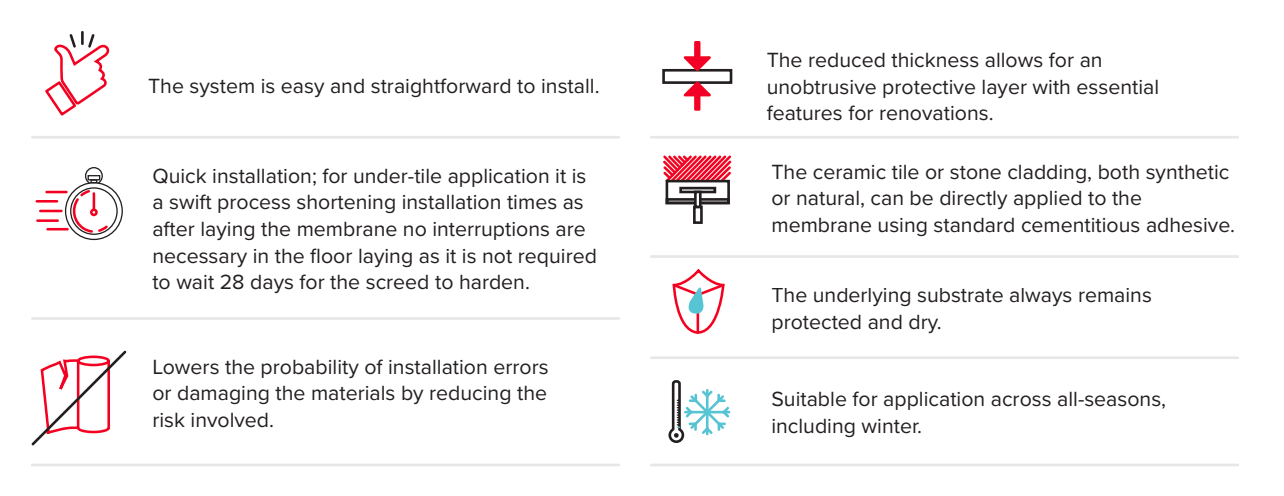There's a new decoupling membrane in town! STRATO from Genesis is a decoupling matting designed to protect tiled floors from cracks whilst also acting as a waterproofing layer. The great news is that this matting can be used both inside and outdoors, so it's a great choice for patio and terrace tile installations.
Features of STRATO:
Decoupling / Crack Bridging - STRATO eliminates the cause for cracked tiles by neutralising tension between the substrate and tiled surface as well as creating a bridge over existing fractures in the substrate.
Vapour Vent - The channels between the polypropylene fabric and HDPE Membrane disperse vapour tension from humid substrates. They act as an outlet for excess humidity and vapour.
Load Distribution - The membrane structure aids the distribution of loads on the tiled surface that can cause damage. It has been classified as "Extra-Heavy" in testing.
Waterproofing - The material characteristics of the membrane when combined with STRATO band provide a waterproof function to your installation. As a result, the substrate is protected from humidity and harmful substances.
Benefits of STRATO:
The matting is made up of a HDPE dimpled membrane layer, with a roughened surface and a spun-bonded polypropylene fabric. It's designed to reduce tensions created by changes in the substrate to protect against cracks. The mat can be applied directly onto the screed and doesn't require a 28-day curing period, allowing for quick installations. Plus it can be used with a variety of substrates, including underfloor heating systems.
- Rolls out straight & flat with no waves
- Quick and easy installation
- Maximum protection for tiling
- Ideal for new build and renovation projects
- Protects tiling against cracking
- High shear elasticity

How to install STRATO:
Before laying STRATO, the substrate should be firm, sound, clean and be under the recommended moisture content. Inserting STRATO MEMBRANE does not eliminate the need for expansion and perimeter joints, for which it is necessary to follow the instructions in the standard UNI 11493-1.
Disconnecting Function
1. Adhesive must be used to lay STRATO MEMBRANE over the substrate, using a notched trowel.
2. STRATO MEMBRANE must be laid over the designated area, with the spunbonded cladded side facing down. STRATO MEMBRANE must then be pressed down into adhesive with the aid of a float, applying pressure to prevent the creation of air pockets. STRATO MEMBRANE must then be covered with another layer of class C2 (or greater) cementitious adhesive. The tiles can then be laid without waiting for it to dry, using a notched trowel of dimensions appropriate for the size of the tiles to be laid.
Waterproofing Function
3. Other measures are required during the laying stage to provide the additional waterproofing function. After laying STRATO MEMBRANE, it is necessary to seal the joints between the adjacent sheets with adhesive, spreading it with the smooth side of the notched trowel.
4. Then STRATO BAND must be applied.
5. The same procedure must be followed for the perimeter waterproofing, then adhesive is applied. 06. Then STRATO BAND must be laid. At the joint, STRATO BAND must overlap it by at least 50 mm. The same procedure must be used for the perimeter joints, using STRATO BAND centred in the floor / wall connection with adhesive. (For outdoor applications in particular, it is important to lay the cladding over the entire area, in compliance with the current reference standard 11493-1)
7. Then the class C2 (or greater) cementitious adhesive must be spread followed by the laying of the finishing product
8. The plinth/skirting board must be kept detached from the floor, the remaining gap must be sealed with elastic material (silicone or perimeter joint profile).


